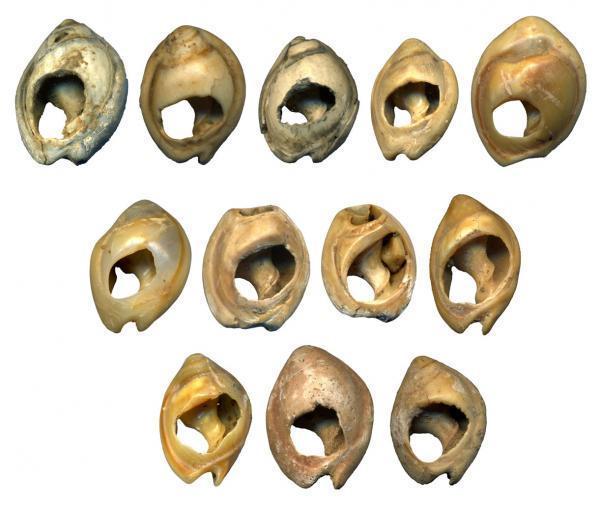Recently, shells were excavated at four locations in Morroco. This reinforces the hypothesis that from 80,000 years ago, people not only wore iconic jewelry but also brought them as exchange objects. These shells add to the 110,000-year-old collection of shells found in Algeria, Morocco, Israel and South Africa, proving that this is the oldest form of jewelry on earth. This information is reported at the US National Academy of Sciences.
In part of the 'Human Origin, Language and Languages' program conducted by the European Science Foundation, a group of researchers found 25 sea shells dating from 70,000 to 85,000 years at Morroco. These shells have holes in the middle. Some had traces of dye and seemed to have been worn for a long time. This allowed the hypothesis they could have been used as jewelry.
Seashells found in all of these locations are of the same age and same species as the Nassarius. The fact that these shells are used in similar capacities in many areas suggests that this is a cultural phenomenon, a tradition spread among cultures for thousands of years. Some places where shells are found are very deep in the mainland.Therefore, it must have been intentionally brought in from other places.
Francesco d'Errico, lead author and research director at the French National Center for Scientific Research (CNRS), said: 'There are two assumptions that explain this. One is that people went to the sea and collected seashells. Secondly, these shells helped to establish and maintain a network of exchanges between coastal residents and land residents. This network also contributes to the exchange of other objects, as well as cultural and racial exchanges. Therefore, these shells help reveal the connection between awareness and culture. '
For the scientific world, shells are not simply beautiful things. They represent a specific technology that conveys information through an encrypted language.This reflects the progressive thinking and development of modern cultural lines, providing evidence that this groundbreaking action may be related to the spread of people outside Africa.
 Perforated sea shells in archaeological floors date from 73,400 to 91,500 years at Taforalt. (Photo: d'Errico / Vanhaeren)
Perforated sea shells in archaeological floors date from 73,400 to 91,500 years at Taforalt. (Photo: d'Errico / Vanhaeren)
'Errico adds ' Inventing personal jewelry is one of the most interesting cultural tests in human history. The common element among jewelry is the message that ancient people want to send to each other. They convey human images, not just a normal biological object. '
Until recently, it was argued that the invention of personal jewelry coincided with the process of European colonization 40,000 years ago, as a result of progressive thinking and population fragmentation. This view was rejected by discovery in 2006. It was found that shells in Africa and the Near East date to about 35,000 years. This proves the way of thinking expressed by symbols appears step by step in human evolution.
Surprisingly, shells are not included in archaeological records recorded in Africa and the Near East 70,000 years ago - the time when cultural breakthroughs occurred, such as carving on loess land, tools made from animal bones and making objects to break and launch. 30,000 years later , personal jewelry reappeared in Africa and the Near East and first appeared in Europe and Asia. This reflects another period of independence in the development of residents.
Temporarily disappearing cultural breakthroughs may be related to a decline in the population during the harsh climate of about 60,000 to 73,000 years ago . The harsh natural environment has separated residents and disrupted social exchanges and social exchanges.
In this study, 21 independent projects and 44 research groups from 12 European countries jointly established the European Science Foundation EUROCORES and run the 'Origin of humanity, language and languages' program. This collaboration brings together a variety of disciplines, including genetic engineering, linguistics, archeology, anthropology, neurology and cognitive science.
Dr. Eva Hoogland, coordinator of EUROCORES ' cognitive science, said: ' This study is a good example of a participatory work environment for many science disciplines. Some problems, such as the relationship between human awareness and culture can only be solved if there is a collaboration of scientists from different disciplines. '
The study also received financial support from the Natural Environment Research Council, the British Academy, Oxford University, England; Max Planck Society, Germany.
 Discovered an ancient centipede fossil 99 million years old
Discovered an ancient centipede fossil 99 million years old Discovered bat-like dinosaurs in China
Discovered bat-like dinosaurs in China Discovered a 200-year-old bronze cannon of the coast
Discovered a 200-year-old bronze cannon of the coast Discover 305 million-year-old spider fossils
Discover 305 million-year-old spider fossils